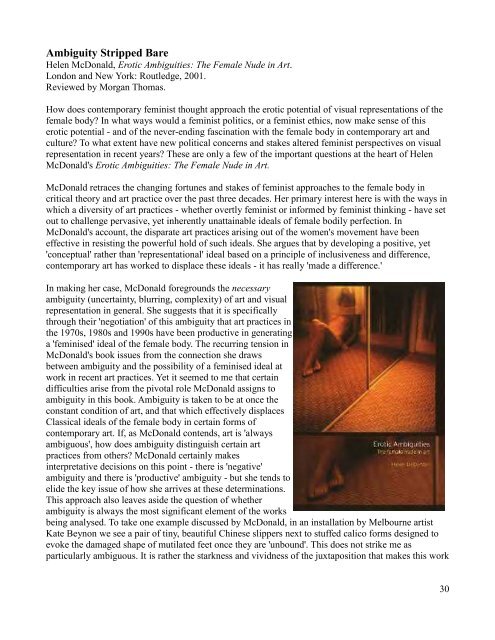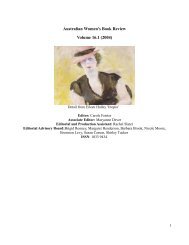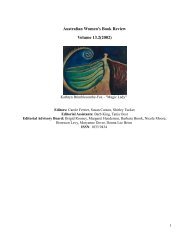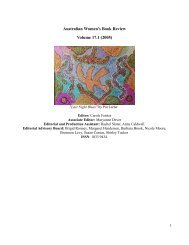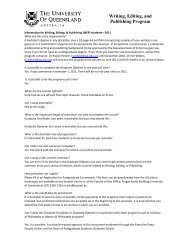Australian Women's Book Review Volume 14.1 - School of English ...
Australian Women's Book Review Volume 14.1 - School of English ...
Australian Women's Book Review Volume 14.1 - School of English ...
You also want an ePaper? Increase the reach of your titles
YUMPU automatically turns print PDFs into web optimized ePapers that Google loves.
Ambiguity Stripped Bare<br />
Helen McDonald, Erotic Ambiguities: The Female Nude in Art.<br />
London and New York: Routledge, 2001.<br />
<strong>Review</strong>ed by Morgan Thomas.<br />
How does contemporary feminist thought approach the erotic potential <strong>of</strong> visual representations <strong>of</strong> the<br />
female body? In what ways would a feminist politics, or a feminist ethics, now make sense <strong>of</strong> this<br />
erotic potential - and <strong>of</strong> the never-ending fascination with the female body in contemporary art and<br />
culture? To what extent have new political concerns and stakes altered feminist perspectives on visual<br />
representation in recent years? These are only a few <strong>of</strong> the important questions at the heart <strong>of</strong> Helen<br />
McDonald's Erotic Ambiguities: The Female Nude in Art.<br />
McDonald retraces the changing fortunes and stakes <strong>of</strong> feminist approaches to the female body in<br />
critical theory and art practice over the past three decades. Her primary interest here is with the ways in<br />
which a diversity <strong>of</strong> art practices - whether overtly feminist or informed by feminist thinking - have set<br />
out to challenge pervasive, yet inherently unattainable ideals <strong>of</strong> female bodily perfection. In<br />
McDonald's account, the disparate art practices arising out <strong>of</strong> the women's movement have been<br />
effective in resisting the powerful hold <strong>of</strong> such ideals. She argues that by developing a positive, yet<br />
'conceptual' rather than 'representational' ideal based on a principle <strong>of</strong> inclusiveness and difference,<br />
contemporary art has worked to displace these ideals - it has really 'made a difference.'<br />
In making her case, McDonald foregrounds the necessary<br />
ambiguity (uncertainty, blurring, complexity) <strong>of</strong> art and visual<br />
representation in general. She suggests that it is specifically<br />
through their 'negotiation' <strong>of</strong> this ambiguity that art practices in<br />
the 1970s, 1980s and 1990s have been productive in generating<br />
a 'feminised' ideal <strong>of</strong> the female body. The recurring tension in<br />
McDonald's book issues from the connection she draws<br />
between ambiguity and the possibility <strong>of</strong> a feminised ideal at<br />
work in recent art practices. Yet it seemed to me that certain<br />
difficulties arise from the pivotal role McDonald assigns to<br />
ambiguity in this book. Ambiguity is taken to be at once the<br />
constant condition <strong>of</strong> art, and that which effectively displaces<br />
Classical ideals <strong>of</strong> the female body in certain forms <strong>of</strong><br />
contemporary art. If, as McDonald contends, art is 'always<br />
ambiguous', how does ambiguity distinguish certain art<br />
practices from others? McDonald certainly makes<br />
interpretative decisions on this point - there is 'negative'<br />
ambiguity and there is 'productive' ambiguity - but she tends to<br />
elide the key issue <strong>of</strong> how she arrives at these determinations.<br />
This approach also leaves aside the question <strong>of</strong> whether<br />
ambiguity is always the most significant element <strong>of</strong> the works<br />
being analysed. To take one example discussed by McDonald, in an installation by Melbourne artist<br />
Kate Beynon we see a pair <strong>of</strong> tiny, beautiful Chinese slippers next to stuffed calico forms designed to<br />
evoke the damaged shape <strong>of</strong> mutilated feet once they are 'unbound'. This does not strike me as<br />
particularly ambiguous. It is rather the starkness and vividness <strong>of</strong> the juxtaposition that makes this work<br />
30


